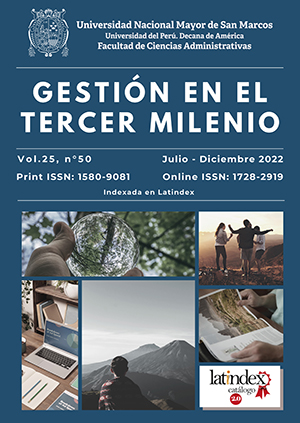Psychometric credit rating and its influence on the profitability of a bank: Entrepreneurial Credit 2018-2020
DOI:
https://doi.org/10.15381/gtm.v25i50.24281Keywords:
Microfinance, psychometric credit rating, effectiveness, efficiency, profitabilityAbstract
The objective of this research is to determine whether the psychometric credit rating in the process of granting credit to microentrepreneurs influences the profitability of a bank specialized in microfinance. This is an applied, explanatory and correlational research, with a non-experimental design and quantitative approach. The sample consisted of the number of psychometric credit rating operations performed to microentrepreneurs as part of the "Entrepreneur Credit" service in the Villa María, Huaycán, Cajamarca, Cusco, San Hilarion and Santa Anita branches of the bank. The final results established that efficiency has a direct influence on the gross and net financial margin, which is corroborated by the coefficients 354.845 and 372.524, respectively. Likewise, these turn out to be statistically significant (with a p-value = 0.000 in both cases). On the other hand, the results are different for efficiency, since it influences the net operating margin, which is reflected in its coefficient 61.358. This result is also statistically significant (p = 0.044). In conclusion: there is a direct and significant relationship between the efficiency dimension and the psychometric credit rating in the process of granting credit to microentrepreneurs, and the gross and net financial margins of the bank. In addition, there is a direct and significant relationship between the efficiency dimension and psychometric credit rating in the process of granting credit to microentrepreneurs and the net operating margin of the banking entity, in the period 2018-2020.
Downloads
Published
Issue
Section
License
Copyright (c) 2022 José Antonio Rojas Babilonia

This work is licensed under a Creative Commons Attribution 4.0 International License.
THE AUTHORS RETAIN THEIR RIGHTS:
(a) The authors retain their trademark and patent rights, and also over any process or procedure described in the article.
(b) The authors retain the right to share, copy, distribute, execute and publicly communicate the article published in Gestión en el Tercer Milenio journal (for example, place it in an institutional repository or publish it in a book), with acknowledgment of its initial publication in the Gestión en el Tercer Milenio.
(c) Authors retain the right to make a subsequent publication of their work, to use the article or any part of it (for example: a compilation of their work, lecture notes, thesis, or for a book), provided that they indicate the source. of publication (authors of the work, magazine, volume, number and date).













